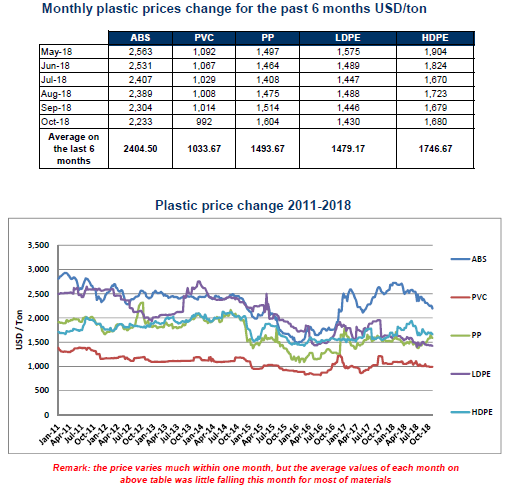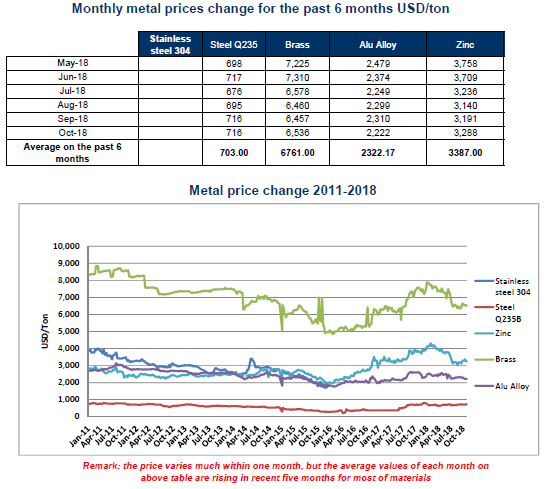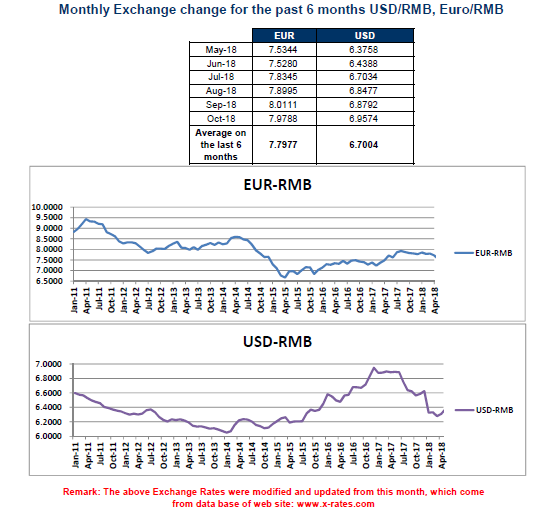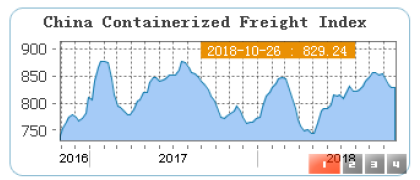RAW MATERIALS INDEX RATE – DECEMBER 2018
Here-under, the index rate of raw materials in China throughout the last 6 months.




Available in PDF : Download Newsletter VVR 2018 NOVEMBER
Here-under, the index rate of raw materials in China throughout the last 6 months.




Available in PDF : Download Newsletter VVR 2018 NOVEMBER
The main traditional and commercial celebrations in China: holidays in 2025 China, with its thousand-year-old history, is a country where tradition and modernity coexist. Traditional festivals play a central role, combining ancestral rituals with family gatherings. Alongside these cultural celebrations, commercial festivals, often inspired by global trends or local initiatives, complete the calendar of key...
Generative artificial intelligence in China: a rapidly expanding technological revolution Generative artificial intelligence (AI), a technology that enables the creation of textual, visual, audio and other content, is developing rapidly in China. With applications ranging from artistic creation to scientific research, not forgetting improved business services, this technology is becoming a strategic pillar of innovation....
Press release: Daxue Consulting joins VVR International Press release Consulting and business services - China / Asia Daxue Consulting joins VVR International Paris / Shanghai, July 25, 2024 - Daxue Consulting, a market research and strategy consulting firm that has supported over 400 clients in China and Asia since 2012, and VVR International, a consulting...




Taobao : It is Alibaba’s e-commerce platform, launched back in 2003. This C2C platform gathers today over 500 millions of active users. Besides, they also developed a B2C platform in 2008 called T-Mall. These two platforms saw the transaction of some 3 trillion yuans over the year 2017.
It is very likely that a large part of the Halloween costumes worn this year in the coastal cities all come from the same place: a small village in a rural province of China, which specialized in the confection of costumes that they then sell online. This is what we call a “Taobao village”, another aspect of the retail revolution taking place in China. In this month’s article, we provide you with a reading of this phenomenon, which we hope can also be a source of inspiration for your approach of the Chinese e-commerce. What are exactly these “Taobao villages”? How rural entrepreneurs with few resources at hand managed to appropriate these tools and how do they use it? Knowing about “Taobao villages” and these micro-enterprises can be of interest, especially for European retail companies who also need to appropriate themselves the Chinese e-commerce.
The official definition of a “Taobao village” is a rural community in which at least 10% of the families use Taobao for retail, or where 100 online shops were open; and where the trading volume reach at least 10 millions of yuans. This definition is given by Aliresearch, the research department from Alibaba, whose mission is to collect and make use of the enormous amount of data Alibaba have at hands. The “Taobao villages” developed themselves firstly with Alibaba (hence their names, from Alibaba’s famous e-commerce platform). The Chinese authorities were then prompt to support these initiatives as they contribute to reach primordial goals set in the 13th Five-Year Plan: eliminating poverty, developing the Western provinces and slowing down the rural exodus. As a matter of fact, 45% of the Chinese population still lives in villages (often much bigger than our European villages). The dose of personal entrepreneurship at the roots of “Taobao villages” is seen very positively by the authorities: seen as one of the key of the development success of coastal cities in China, entrepreneurship now moves to the countryside. Today, JD.com are promoting their own platform to rural communities.
Increasing by 25% in 2015, the number of “Taobao villages” reached 2 118 in 2017, with a total of 120billion of yuans in sales (Aliresearch). Overall, 1.3% of the Chinese population is involved in some e-commerce activity in 2017 (approximately 10 millions). Alibaba’s support is concretized in a 2017-2019 investment plan amounting to 1.6 billions of dollars. Their objective is to open 100 000 Taobao centers in rural places. The Chinese government also makes substantial investments (for the reasons mentioned above). It claims 300 millions of dollars allocated to 200 rural counties to build warehouses, train skilled manpower… The government overtly encourages young Chinese to come back to their native villages to open businesses. It seems so far to be working as 52% of these online entrepreneurs are less than 30.
These statistics seem to point at the success of a rather new business model, with a unique management style: these micro-enterprises are often run by people will low qualification level, who seize the opportunity of low entry barriers to experiment, test their products with the market and adapt them, thanks to the statistics provided by Taobao and the customers feedbacks available. Most of these micro-enterprises produce in the villages and then sell in the cities, but some are the other way around. For those who sell in the cities, e-commerce brought them a significant improvement as it abolishes distances and they could get access to markets where consumers have more purchasing power. Regarding what is sold, there are different strategies. Some villages get specialized in the local food products (Ningxia’s Goji berries, Suichang’s bamboos shoots, tea and sweet potatoes…) while some others get specialized in a product that is not related at all to their localization (outdoor equipment, costumes…) An interesting pattern then stands out: most of the time, the online shops of a village all get involved in the same activity, bringing the specialization to the level of the village (and constructing thereby a sense of identity within the products). The very denomination “Taobao villages” implies an organization to the level of the village. Lastly, it seems that local food products are more successful as consumers await local products that are cheaper and potentially healthier (organic agriculture).
Not only do “Taobao villages” bring new products to the coastal cities’ consumers, but it also impacts on the very structure of these villages, creating new associations. In order to guarantee a certain quality for instance, some villages put in place “Taobao associations”, in a way similar to the industry chambers. Moreover, “Taobao villages” require a development of the tertiary sector (sales, delivery, storage), which in some cases amounts to 50% of the local gross product. At last, other activities develop, such as the eco-tourism. This last aspect is all the more interesting as it is also readily observable in Europe. Not mentioning the thematic travels around Europe (such as “Grands Crus tours” in Fance), every year more numerous, one can think of this small Bulgarian village, Momchilovtsi, which local yogurt became extremely popular in China recently, albeit because of a company and not because of e-commerce. As a result, this village now sees buses of Chinese tourists coming to visit. This example is telling as it shows the strength of local identity in nowadays branding in China.
“Taobao villages” actually do not alwqys run so smoothly, and they do encounter some difficulties. First of all, access to digital technologies is still limited in rural China with 1% of the families having a broadband connection in most of the villages (the official goal announced in “Internet+” is a 98% coverage by 2020). Another limit which is more closely linked to the e-commerce characteristics: branding remains limited and many businesses suffer fakes issues. Thus, in Qingyangliu, a “Taobao village”, only 20% to 30% of the businesses are making profit. The identified cause is the fact that the market is saturated and dominated by large companies.
Seeing either as an opportunity, or as a concept with a debatable long-term profit, “Taobao villages” nonetheless are a characteristic trait of the revolution of retail in China. They picture the dynamic entrepreneurial mindset of Chinese businessmen. They also confirm the analysis that e-commerce in China do open many opportunities because of the low entry barriers and larger access, but that many challenges remain when it comes to build a brand image on this already saturated market.
By Manon Bellon
Image credits: Greg Jenkins
Agri-food in China: a market between dependence and diversification A strategic market at the heart of global food tensions In 2024, China imported 188 billion euros worth of agricultural and agri-food products. This impressive figure reflects a structural reality: despite its desire to move towards self-sufficiency, China must rely on imports to feed its population...
Dog or cat? Preferences change in China and the market adapts In China, pets are particularly popular with young urbanites in search of affection, home comforts and new landmarks. This craze for dogs and cats is driving sustained growth in the pet food and care market of over 13%, reaching an impressive 300 billion yuan...
China opens opportunities for foreign-owned hospital operations: What foreign healthcare companies should know Foreign-owned companies can now direct clinical operations and open 100% foreign owned hospitals in some Chinese cities. On September 7th 2024, China’s Ministry of Commerce, National Health Commission and the National Medical Products Administration announced the opening up the medical sector and,...




China is expected to reach 7 million new energy domestic vehicle (NEV) sales by 2025, according to Beijing’s 13th Five-Year Plan, finalized in 2015. Chinese NEV sales – the term China uses to refer to battery-electric vehicles, plug-in hybrids and fuel-cell cars – totaled 951,477 units between January 2011 and December 2016. These figures, which include passenger cars and heavy-duty commercial vehicles, have already made the Middle Kingdom the largest electric vehicles (EVs) market in the world, with 37.7% of global sales in 2016.
To address China’s dependence on oil exports and severe air pollution due to an overuse of coal as a main form of electricity production, the government announced in 2010 a trial program to provide monetary incentives for NEV automakers in five cities. The amount of the subsidies stood at 30 billion RMB (USD 4.4 billion) in 2016.
To further boost NEV sales, the government is luring Chinese consumers to adopt electric vehicles by promising charging stations. Beijing plans to install 400,000 charging points in the capital city by 2020. NEV consumers also benefit from central and local governments via cash subsidies, free parking spaces and free license plates.
After several car makers were fined for defrauding the subsidy program, Beijing enacted a new subsidy policy in August 2016, where only qualified manufacturers are eligible to receive NEV subsidies moving forward. More than a third of Chinese manufacturers, which fail to meet the policy’s qualification standards, are expected to be left out. The Ministry of Industry and Information Technology (MIIT) also recently announced a restriction on the granting of licenses to new electric vehicle (EV) startups, limiting the number to just 10 per year.
Reduced subsidies and new policies caused he stock of EV sales to slump in January 2017, compared to a year earlier. Sales of NEVs dropped 74 percent to 5,682 unites, according to the China Association of Automobile Manufacturers (CAAM).
The downsides of China’s supportive policies are emerging in the form of overcapacity and imperfect competition. More than 200 Chinese NEV manufacturers have thus entered this market to date, producing more than 4,000 licensed NEV models. Another hurdle to a mature market is that low-cost, low quality NEVs dominate. Sixty percent of China’s NEV market share belongs to low-cost cars, whereas less than 20 percent of the market share belongs to high-end ones.
One can only wonder what opportunities foreign eco-friendly carmakers have left in a very protectionist country, where the Chinese automotive brand BYD has been topping the segment sales for several years. Surprisingly, some do exist. Volkswagen recently signed a joint-venture agreement with Chinese manufacturer JAC Motor to mass produce 8 new EVs in China by 2020. Tesla Motors also is in talks to set up a factory in Shanghai.
Opportunities exist in power battery manufacturing as well. This key component of EVs has begun a period of rapid growth and strong demand for lithium-ion batteries. Last year, changes to Chinese legislation allowed foreign firms to set up wholly-owned electric vehicle battery manufacturing plants in free-trade zones in Shanghai, Guangdong, Tianjin and Fujian.
On a less positive note, while China seems to gradually open-up its EV battery market to foreign companies, conditions still favor domestic suppliers. In June 2016, MIIT left some prominent foreign companies off a list of battery manufacturers approved to receive government subsidies, including Samsung and LG, which have been manufacturing batteries in China for many years. Exclusion from the list means that from January 20 18, manufacturers of EVs using batteries made by manufacturers not included on the approved list will not be eligible for government subsidies.
Even if still booming thanks to government subsidies, the future of China’s NEV market remains uncertain and challenging.
Agri-food in China: a market between dependence and diversification A strategic market at the heart of global food tensions In 2024, China imported 188 billion euros worth of agricultural and agri-food products. This impressive figure reflects a structural reality: despite its desire to move towards self-sufficiency, China must rely on imports to feed its population...
Dog or cat? Preferences change in China and the market adapts In China, pets are particularly popular with young urbanites in search of affection, home comforts and new landmarks. This craze for dogs and cats is driving sustained growth in the pet food and care market of over 13%, reaching an impressive 300 billion yuan...
The aeronautics sector in China in 2024: growth and business opportunities Introduction China's aerospace sector in 2024 is showing strong growth, underpinned by massive investment in infrastructure and technological advances. As China surpasses pre-pandemic levels in several areas, the industry also offers promising prospects for foreign companies. This article explores the highlights of this recovery...



